« September 2013 |
Main
| November 2013 »
 October 31, 2013 | Paul Glasse on composition and line
October 31, 2013 | Paul Glasse on composition and line
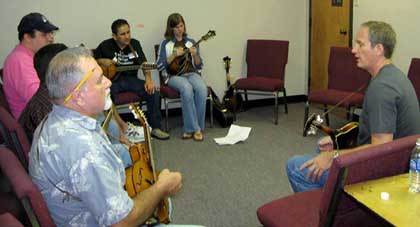
We enjoy picking the brains of the pros on how they go about creating good improvisation. In our December 2009 interview with Paul Glasse, the question came up, and as usual, Paul came up with some great answers. The following is an excerpt you'll find helpful on devising your own strategy.
Question: What note choices or avoidance thereof do you find helpful in designing hip sounding bebop lines? Are there particular "snippets" of note patterns that you find always seem to come up? Is there a method you use when first attacking a jazz standard? i.e. find all the 3rds and 7ths in the chords, etc... I'm looking for the fishing pole and net here so I can try and come up with my own fish.
Paul Glasse: I think when I first started trying to play swing, and bebop that I tended to err on the side of playing too many roots to the chords, spelling things out too literally and just naturally trying to neatly tie up all the melodic loose ends. As I've played and listened more I've become more familiar with jazz vocabulary and in the process become more comfortable with melodic ideas that unfold gradually and don't always resolve themselves neatly right off the bat. I think that it's OK to pose a melodic question.
When first attacking a jazz standard I really don't use one specific system. I try to learn the chords and melody. I look for how the two work together--that is be able to play the melody and understand how it relates to the chords and vice versa. I generally try to solo over the chords a few times and deal with things in a few different positions and or registers, making sure to hone in on any unique harmonic moments of the particular tune.
While I don't have a system for it, I guess I do, at any given moment of a song, want to be dialed in on what's going on harmonically--yes, 3rds and 7ths are really important. Idiomatically, the drop from a root to the 3rd below it crops up a lot in bop lines as does the overlaying of blues vocabulary with various other approaches, such as chord substitution or alteration of extension tones. If the original tune has lyrics it can be helpful to know those--just another route to really getting inside the song.
In an ideal world we could all just create endless, inventive, melodic variations on tunes without thinking through any kind of technical filter. I think, while we might have times that this actually works, in truth, most of us are aided by some technical stuff. The technical thinking may help us figure out some safe things to play, or might help us identify (and find on the instrument) what we're already hearing in our head. I find that I play best when I'm able to bring several of these levels to bear--either at the same time, or at least rapidly transition between approaches. Within a given tune there may be sections that I can approach very intuitively, without much conscious thought, and other points when I may have to play more deliberately to technically negotiate a harmonic hairpin turn in the tune. Invariably, the more any of us plays, the more we just hear "better" and can increasingly trust our ears and instincts.
Further:
Paul Glasse Interview
Thin-slicing and Music Theory
Building a solo
Going beyond "playing."
Improvisation Techniques
Visit: Paul Glasse Reverb Nation Page
Music on Amazon
Posted by Ted at 1:32 PM
 October 24, 2013 | Best of JM: Sneaking Theory
October 24, 2013 | Best of JM: Sneaking Theory
Enjoy the popular archive material below.
From October 9, 2008 | Sneaking Theory
We frequently include in our weekly JazzMando Tip of the Week column, answers to very good questions we get from our Contact feature. We're serious about responding, and when we feel there will be benefit to a multitude of students, we'll share these with you. This one is about the initial FFcP exercises, from Marcus in Iowa. Note these are also available as a free download here on the website: FFcP lesson, and PDF. (Repeated in the Mandolin Cafe Lessons resource.)
Question:
I've started the book. My pinky is quite stout already, lucky me. So what are these designations vi7, ii7, and the like that I'm seeing for individual measures in the early exercises? (I might have typed these designations incorrectly since I'm doing this from work, but I think there are four of them).
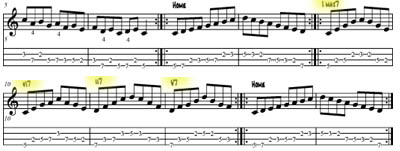
Answer:
These are chord designations, and we go into a little more detail on these page 53 of the book. You're basically spelling out chords, the six (vi7), the two (ii7), the five (V7). It's our way of "sneaking in" music theory through the physical. The intent is that after several weeks of working through these, getting them into the fingers, and ultimately the ears, an "Aha!" moment will happen. "Oh, I've been playing the "Doo wop" chords all along, and I didn't even know it!" (Think the chords to "Heart and Soul" or "Why do Fools Fall in Love?")
We didn't want to confuse people with too much theory early in the book, but it's important to at least give it a little lip service. Again, the important directive at this early stage is firmly establishing the "tactile." Through repetition, the fingerings become intuitive, so that eventually, the brain can start attacking the more cerebral aspects of harmonic/melodic construction.
Once these "labels" mean something, you'll have developed a higher brain concept that will enable you to repeat key improvisational discoveries, licks and nuggets from one tonal center to another, consciously and intuitively.
Hey. Buy the book!...
Getting Into Jazz Mandolin
Further
Variables
Approaching Improvisation
Suspicion of Melodic Intent
The Jazz Brain; Improv
Posted by Ted at 8:26 AM
 October 17, 2013 | Mandolin Family Specs
October 17, 2013 | Mandolin Family Specs
Once you get outside of the sizes of a standard mandolin body and its scale (generally within 1/4" of 14"), things can get confusing as to how big a mandola, octave, and mandocello should be. It can be most annoying when shopping for string sizes or determining tensions for a custom gauge set of strings.
It really gets dicey when you compare European and North American terminology for what a mandola and octave vs. a tenor or alto mandola might be. Throw in the individual cottage builder experimentation, and you'll find quite a variety of size variation, and sometimes even tuning. Many players even experiment with using octave pairs on the wound strings.
Nothing says you can't experiment, but we'd like to propose one source as a "go-to" standard for sizing. Because Bruce Weber and crew has done such a masterful, prolific job of delivering a wide range of mandolin family instruments domestically and around the world, we'll use his page as a good reference.
Click on the image below to get to the Weber Mandolin Measurements page for more detail.
Website: Mandolin Family Specs
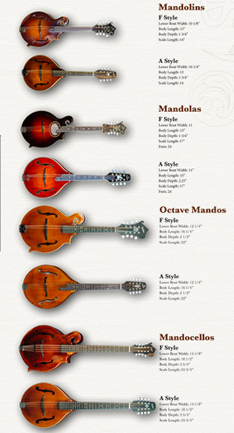
As we mentioned, the variation gets broader the bigger the instrument. We tend toward the smaller body scales, 16" vs 17" on mandola, but this is all personal preference. Anything larger than that requires a different approach than the FFcP system for closed pattern scales and chords. Factor in hand size and music style as well. Plus you can sacrifice some volume with the smaller size variation.
Posted by Ted at 9:09 AM
 October 10, 2013 | Tim O'Brien on mandolin warmup exercises
October 10, 2013 | Tim O'Brien on mandolin warmup exercises
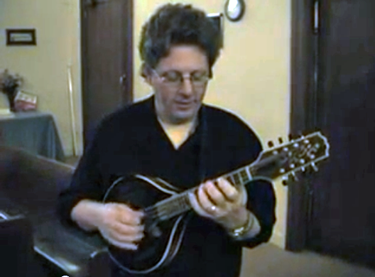
In the following D'Addario produced video, mandolin royalty Tim O'brien demonstrates a theoretically simple approach to a scale warm-up using the simple notes of the A scale. He plays the scale starting on different notes, and keeps the music theory simple by not mentioning what more advanced students will recognize as modes (dorian, mixolydian, lydian, etc.) because the intent is to get you to move the scale up the neck.
Sometimes labels only confuse...
Video Link: Tim O'Brien On Mandolin Warmup Exercises
He makes it look simple, but don't worry about speed right away. Aim for precision, and take advantage of his tip on using the A notes as reference points in the scale. He's in essence splicing a 1st FFcP scale in the bottom with a 4th FFcP in the second octave, so if you're fluent in the FFcP approach, this may very well come easy.
He also breaks it up into chords (AKA arpeggios), which can also be the basic building blocks of your improvisation. He breezes through them toward the end, but don't let that intimidate you. It might take a few days (or weeks) before you can get up to speed with them.
Another very good tip is his suggestion to start the exercise from the top note of the scale and work your way down. This would be an excellent way to run your FFcP exercises. We don't play our melodies down to up all the time, and it's good to develop your own mental reference points practicing this way.
Review FFcP
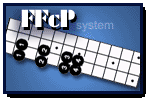
Posted by Ted at 5:49 AM
 October 3, 2013 | Best of JM: Guitar to Mandolin
October 3, 2013 | Best of JM: Guitar to Mandolin
Enjoy the popular archive material below.
From May 27, 2010 | Guitar to Mandolin
Many mandolinists have taken that path of branching out from months or years of playing guitar to our small 8-string wonder. Whether they are driven from (in the case of a frustrated guitarist) or drawn to, the mandolin offers a whole new world of sonority, expression, and challenges. We want to explore some important concepts for those pondering that move.
First thing to remember: It's not a little guitar.
Despite the similarities, strings, frets, pick, wood, etc, the mandolin is really an instrument of its own. The size and tuning are the most obvious difference, but there is a common misconception in how small hands have to be to play the mandolin. While a guitar player is used to chromatic one finger-one fret in most playing, the mandolinist (like the violinist) skips a 1/2 step and for the most part things of the instrument diatonically. In other words, one note per note of the scale, occasionally 1/2 steps but mostly two frets at a time per finger. Fingers spread from 1st to 4th fret will stretch 5-1/8", at the most on a guitar. On a mandolin that same index to pinky stretch at the most is 4-5/8", 1st fret to 7th.
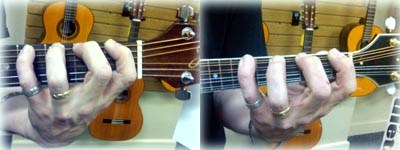
It should make you chuckle when a guitar player bemoans, "I could never play the mandolin; my fingers are too big."
It's critical to understand the three things a mandolin does well in departing from the "little guitar" approach: tremolo, soprano melody, and cross picking. Yes, you can do the clacky, clacky accompaniment chord thing, but we'll explain in a moment the dangers in making this your only skill.
Tremolo. The double course and lighter gauge mandolin strings make a tremolo work far better than you could dream. Even Django Rheinhardt was teased about making his instrument sound mandolin-like. It's associated with it in Europe literally for centuries. This is an effect to exploit, so take the time to master it.
Soprano Melody. When the rest of the band plays lightly and the mandolin is exposed playing the melody, the angels sing. That lighter timbre is a welcome contrast from the heavier instruments. You need to master a smooth sense line, notes bleeding from one to the next. Connect, connect, connect, all the time. Shorter strings decay quicker so you need a good articulation with the pick and an even more secure left hand grip in between the frets.
Cross picking. You won't have the multiple finger pick attack of the banjo, but that piercing flow of notes isn't always what the audience wants to hear. The mandolin allows a subtle subdivision that lends the ensemble energy without being overbearing. Good cross-picking technique is well worth the investment of time.
What not to wear.
We mentioned the "clacky, clacky" chording thing. It's not horrible when the mandolin is solo, although without the lower tenor register, the mandolin makes for a tepid accompaniment instrument. It's okay for variety sake, but after several songs, the ear wants to hear some bass. Worse, when you have mandolin and guitar playing clacky chords together, they have to be impeccably in sync or it sounds awful. Bad news too--the mandolin gets blamed no matter who is off. The audience hears rhythmic irregularity, and ultimately, the higher instrument gets the blame. You are far better off lending the band the simplified back beat "chop" of a steady, metronomic pulse.
It's great if you can do mandolin and guitar. Not everyone can handle the multi-instrumentalist switching back and forth thing, and it's not uncommon to see a mandolinist completely give up the guitar. One direction you can go to avoid confusion is to pick up a tenor guitar which is tuned CGDA like a mandola, or sometimes like an octave mandolin GDAE. Same with a tenor banjo, but we'll leave that for another time.
Further:
Line, Please? The importance of sustain.
Complements of you...
Punctuation and percussion; what you can learn from a good drummer.
Plays Well With Others...
Posted by Ted at 1:23 PM

Disclaimer: In the 'Information Age' of the 21st Century,
any fool with a computer, a modem, and an idea can
become a self-professed 'expert." This site does not
come equipped with 'discernment.'
|



